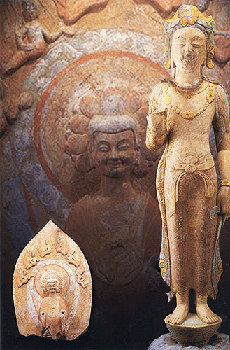Buddha statues found from a storage pit, mainly dating back to the Northern Wei Dynasty (386-534), Eastern Wei Dynasty (534-550) and Northern Qi Dynasty (550-577)
Location: Qingzhou, Shandong Province
Period: 529-1026
Excavated in 1996
Significance: These statues are significant materials to the study of the history of Buddhist art in China.
 Introduction
Introduction
LongxingTempleis a famous Buddhist temple with a history of about 1,000 years. One of the reasons why theLongxingTempleis so important is that it provides a historical continuum of the Buddhist plastic arts inChinafrom the Northern Wei through to the end of theNorthern Qi, and thus a chance to document stylistic changes influenced by shifting alliances between north and south during this turbulent period.
|

|
| Colored statue of standing Buddha in stone: (left, the remnant height is 121.5 cm); Colored statue of standing Bodhisattva in stone: (right, height 95 cm) |
The storage pit is located in the northmost of the temple, with a length of 8.7 meters from south to north and a width of 6.8 meters from east to west. In the pit there are more than 400 Buddha statues in various types and carving skills, of which the biggest is 320 centimeters high while the smallest only 20 centimeters high.
The Buddha statues, which include Buddhas, Bodhisattvas, and arhats, as well as a large number of elliptical figural stelae, offers an interesting contrast in styles. The earlier Northern Wei Buddhas generally wear a loose outer robe that covers both shoulders and an undergarment tied at the neck, a combination known in Chinese asBaoyibodai, and representing a Sinicisation of the traditional Indian Buddha robes. By the Northern Qi period, the flimsier robes covered only the left shoulder and were closely moulded to the soft contours of the body, a style that can be seen both in early Indian Buddhist sculpture and that of Buddhist regions of Southeast Asia, such as Cambodia.
The discovery and excavation of the storage pit atLongxingTempleis by far the largest and most significant group of Buddha statues.
